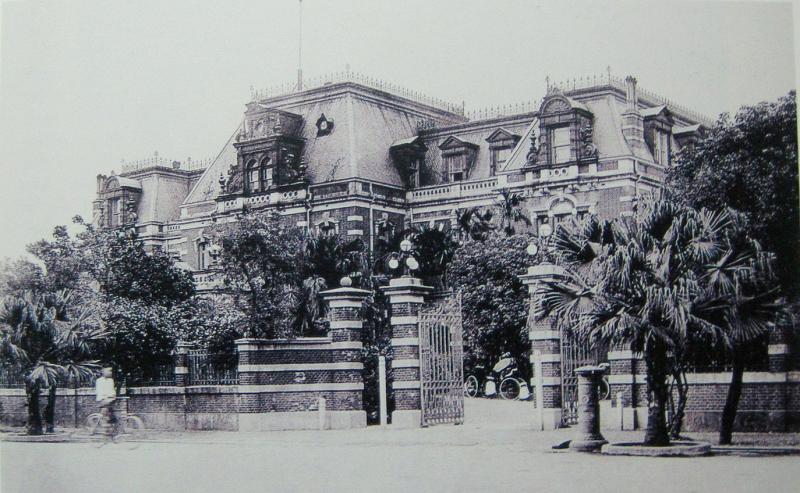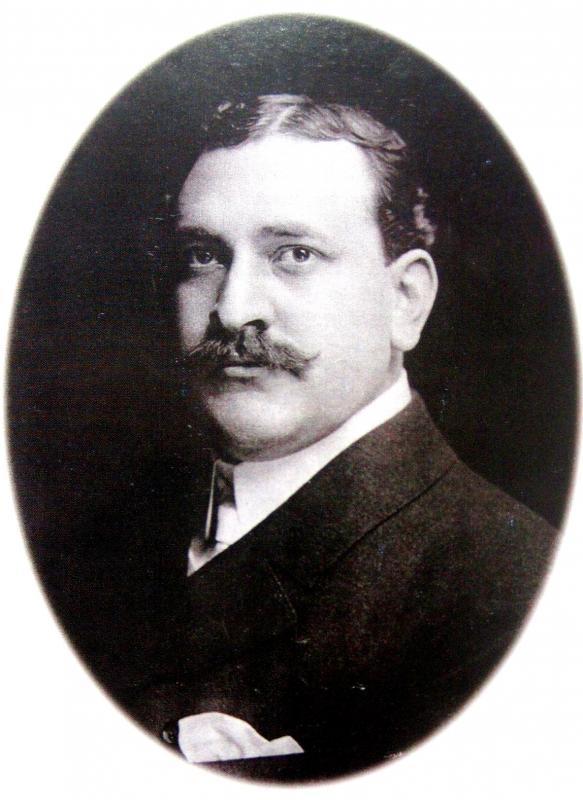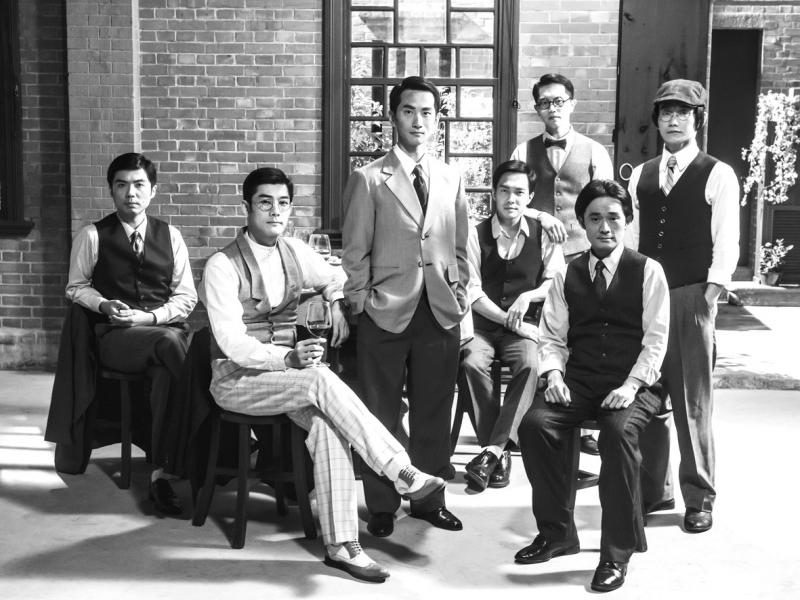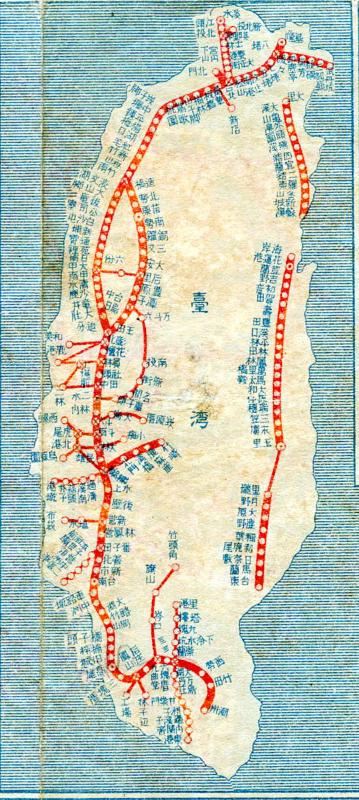Oct. 18 to Oct.24
To chief engineer Kinsuke Hasegawa, the completion of the Taiwan Railway Hotel was just as important as the launch of Taiwan’s first north-south railroad.
Many guests — most notably Japan’s Prince Kotohito — would be coming to Taiwan for the Western Trunk Line’s inauguration ceremony on Oct 24, 1908, and it was imperative to host them at the extremely lavish new establishment. Hasegawa personally presided over its construction for the final months, which carried on day and night with over 1,200 workers toiling in shifts.

Photo courtesy of Wikimedia Commons
They just made it — four days before the official ceremony. Designed by German-educated architect Tsumunaga Matsugasaki, the European-style, red-brick structure was Taiwan’s first Western hotel. Destroyed when the US bombed Taipei in 1945, it was located where today’s Shinkong Life Tower stands in Taipei.
The building resembled other notable colonial structures in the area, including the governor-general’s office, but it was reportedly the first to feature French-style mansard roofs, which frequently appeared on future government buildings. The hotel housed the nation’s first elevator, and boasted a bar, barber shop, reading room, tennis courts and a swimming pool.
Anyone could stay at the hotel, but its room rates limited customers to the wealthy and privileged. In 1935, only 5 percent of guests were Taiwanese, while 74 percent were Japanese and 21 percent foreigners. It never turned a profit, but the government poured money into it to keep it afloat, not only as a status symbol to show visitors the progress of the colony, but also as a popular venue for official events, banquets, conferences, exhibitions and artistic performances.

Photo courtesy of Wikimedia Commons
PURE LUXURY
Matsugasaki, a Japanese noble/royal, spent the bulk of his formative years in Germany. He was made a baron in 1884 after his return to Japan, and first became acquainted with Taiwan after designing former governor-general Taro Katsura’s residence.
It’s said that Matsugasaki’s unfamiliarity with the Japanese language impeded his career success in his homeland, and in 1907, he came to Taiwan to work for the colonial railroad department, which was on the verge of completing Taiwan’s first north-south railroad.

Photo courtesy of Green Film Production
He was much more prolific in Taiwan. In addition to the hotel, he also designed the railway stations in Keelung in 1912 and Hsinchu in 1913 — the latter still stands today. Another one of his existing works is Ximending’s Red House Theater, which he co-designed with Juro Kondo. His final project was the 1918 Taichung Assembly Hall, which was demolished in the 1980s.
Everything in the Taiwan Railway Hotel was top-notch. Under the management of Atsushi Fukushima, known as the “wizard of hotel management,” the hairdressers were trained at Tokyo’s Imperial Hotel and knew the latest Western hairstyles and beauty trends. The game room had both pool and billiards tables, and even employed a billiards instructor to teach guests.
Fukushima was immensely proud of the hotel’s Western-style restaurant, which featured European-trained chefs and a cellar full of top-shelf wine and spirits from across the world. The restaurant only used imported Canadian flour for its home-made bread and worked with government researchers to develop its own brand of soda. Patrons recall little details such as how the fruit was served with a little bowl of water for them to wash their hands with.

Photo courtesy of Wikimedia Commons
While most of the furnishings were imported, the rooms’ rattan chairs and wooden tables were made by inmates from the Taipei and Tainan prisons. The two deluxe suites cost 15 yuan per night, which was about half the monthly salary of a schoolteacher and was enough to feed a family of four for a month.
The hotel was not sustainable. It only achieved its opulence through government funding, and there would not be another official structure like this. The nation’s second railway hotel, established in Tainan in 1936, was much more modest.
WITNESS TO ACTIVISM
Noted anti-Japanese activist Lin Hsien-tang (林獻堂) was one of the few Taiwanese who regularly visited the hotel. He preferred to sleep in Taiwanese-run establishments in the Dadaocheng area, but he booked the railway hotel’s deluxe suite at least once. Many of the elite Taiwanese then were also political activists pushing for more autonomy, and the hotel witnessed its share of historic moments.
With Lin as a cofounder, the Taiwanese Assimilation Society was formed at the hotel in 1914. Boasting more than 3,000 members, the group called for equal treatment for Taiwanese and Japanese. The group invited civil rights activist Taisuke Itagaki, the founder of Japan’s first political party, to speak that year, also housing him in the hotel.
The completion of the railway made it much easier for the activists to spread their message, and the movement grew quickly despite the government shutting down the society in 1915.
In 1930, the Taiwan People’s Party (TPP) informed the League of Nations that the Japanese government was manufacturing and selling opium to Taiwanese. The league’s opium agents happened to be in East Asia, and they arrived in Taihoku (Taipei) on Feb 19.
The government tried to get on their good side by having them stay in the railway hotel, so the TPP sent all the incriminating evidence there. Despite government interference, on March 1, Lin and his colleagues met with the agents in the hotel.
This is one of the incidents that led to the government banning the TPP in 1931. A month after its demise, party cofounder Chiang Wei-shui (蔣渭水) visited Lin at the hotel to discuss the future direction of the movement. The two had fallen out earlier due to ideological differences, and the discussion went nowhere as Lin was still against Chiang’s leftist objectives.
The next day, the Japanese police visited Lin at the hotel, asking him if he and Chiang were planning on starting another party. Lin replied that his stay was purely business.
NOTABLE PATRONS
In addition to Prince Kotohito, the hotel hosted a number of prominent customers. It hosted another prince, Kuni Kuniyoshi (current emperor Akihito’s maternal grandfather), in 1928.
There were “rare guests with azure eyes,” including American aviator Art “Bird Boy” Smith, who arrived in 1916 as part of an Asian tour to show off his acrobatics. Smith’s performance inspired a then 16-year-old Hsieh Wen-ta (謝文達) to become the colony’s first Taiwanese aviator. In 1923, a group of 450 American tourists on a luxury cruise made a day trip from Kirun (Keelung) and dined at the hotel.
In 1926, the Japanese revealed the name of the new variety of rice they were growing in Taiwan in a ceremony at the hotel. “Ponlai rice, Ponlai rice,” then-head of the bureau of productive industries Katayama Saburo read twice on stage.
Explorer and businessman James W. Davidson, author of The Island of Formosa: Past and Present, stayed at the hotel in 1931 during his tour to promote Rotary International in East Asia. He made a presentation to prominent citizens during a luncheon at the restaurant.
The hotel hosted the founding ceremonies of two important art associations: the Taiwan Watercolor Society in 1927 and the Taiyang Art Research Association (台陽美術協會) in 1934.
After the original building's destruction, the Chinese Nationalist Party (KMT) reopened the hotel in a nearby building and ran it for several years. The Jinhua Hotel (金華飯店) and Shin Kong Life Insurance’s founding headquarters were built on the original site in 1963 .
Jinhua was replaced in 1973 by the Hilton Hotel (today’s Caesar Park Hotel), which was Taiwan’s first five-star international hotel.
Taiwan in Time, a column about Taiwan’s history that is published every Sunday, spotlights important or interesting events around the nation that either have anniversaries this week or are tied to current events.

Exceptions to the rule are sometimes revealing. For a brief few years, there was an emerging ideological split between the Democratic Progressive Party (DPP) and Chinese Nationalist Party (KMT) that appeared to be pushing the DPP in a direction that would be considered more liberal, and the KMT more conservative. In the previous column, “The KMT-DPP’s bureaucrat-led developmental state” (Dec. 11, page 12), we examined how Taiwan’s democratic system developed, and how both the two main parties largely accepted a similar consensus on how Taiwan should be run domestically and did not split along the left-right lines more familiar in

This month the government ordered a one-year block of Xiaohongshu (小紅書) or Rednote, a Chinese social media platform with more than 3 million users in Taiwan. The government pointed to widespread fraud activity on the platform, along with cybersecurity failures. Officials said that they had reached out to the company and asked it to change. However, they received no response. The pro-China parties, the Chinese Nationalist Party (KMT) and Taiwan People’s Party (TPP), immediately swung into action, denouncing the ban as an attack on free speech. This “free speech” claim was then echoed by the People’s Republic of China (PRC),

As I finally slid into the warm embrace of the hot, clifftop pool, it was a serene moment of reflection. The sound of the river reflected off the cave walls, the white of our camping lights reflected off the dark, shimmering surface of the water, and I reflected on how fortunate I was to be here. After all, the beautiful walk through narrow canyons that had brought us here had been inaccessible for five years — and will be again soon. The day had started at the Huisun Forest Area (惠蓀林場), at the end of Nantou County Route 80, north and east

Specialty sandwiches loaded with the contents of an entire charcuterie board, overflowing with sauces, creams and all manner of creative add-ons, is perhaps one of the biggest global food trends of this year. From London to New York, lines form down the block for mortadella, burrata, pistachio and more stuffed between slices of fresh sourdough, rye or focaccia. To try the trend in Taipei, Munchies Mafia is for sure the spot — could this be the best sandwich in town? Carlos from Spain and Sergio from Mexico opened this spot just seven months ago. The two met working in the